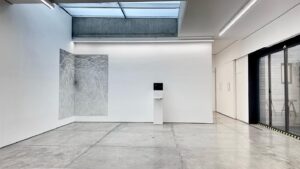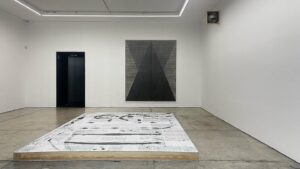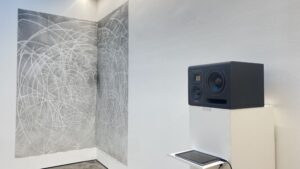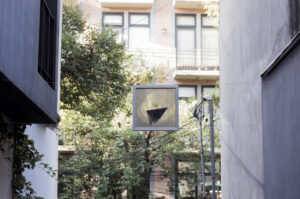Transforming sound into an image furnishes visual space to the drawing. Following such a premise, the exhibition aims to steer visitors between the single sound and the single drawing, that is, through various emotional layers, into a whole. The latter to the extent that the succession of sound and visual events takes place in a single manufactured form: “being in the time between its beginning and its end.” The sound takes shape through a motion of continuous transformation (an antithetical and synthetic process) that alternates being and non-being, the beginning, the end, and then again. The temporal terms of sound also appear in the drawing and its successive elements.
The art of translating sound into images has deep roots in human life’s emotional sphere. It has the power to broaden the boundaries of the imagination, amplifying our affective concept of sound. The natural correspondence between feeling and auditory expression is a collective heritage of those who love and listen, just like drawings from form to gesture offer us infinite possibilities to discover and desire.
A wave transformed into a sound with its unique characteristics in our mind. An elastic body that vibrates with melodious motion radiates a whole series of fundamental frequencies of disharmony and harmony, which are then translated by the brain into a sound image. These representations lie downstream of the physical process of production and propagation of the vibration wave. Sound is a pulsation of the body that becomes an intellectual representation. As an internal image, it has a particular emotional structure. Subjective representations of sound can be translated into an objective signal, a drawing, or a complex system of signs or traces such as writing.
Let us start by introducing the work of Michael Brewster USA (1946-2016), a pioneer in sound production for over 40 years. Michael Brewster’s work exists in the complicated intersection between visual and auditory arts. Neither music nor sculpture; in his pieces, Michael employs devices from both artistic fields to construct an immersive, hybrid art installation. This is the first time Michael’s work will be shown in Mexico City. Therefore, in this exhibition, we want to introduce some of his repertoire’s acoustic works, including Archival Ephemera and his design drawings.
“An acoustic sculpture is a mix of electronic tones emitted into a determined place on a single speaker. These sounds echo into each other to produce a sound field populated by places of varying volume and tonal content. To see an acoustic sculpture, we need to shift our appreciation habits from “stand and watch” behavior to an exploratory “move and listen” approach. We have to slowly turn our ears, instead of moving our eyes, through the elaborate spaces of the “room.”
Michael’s art sublimates physical reality to reconnect it with the spiritual realm. It is alchemy of sound events that we can relish in our space-image, a sort of place-non-place that follows the natural laws of the world inner. Our body is the instrument of dialogue between, so to speak, these two worlds. Through the body (physics), we perceive sound, which is then transformed into psychic and emotional representation (metaphysics). Through the interpretation of Michael’s work proposed here, the transformation of the physical world’s external-temporal dimension into the spiritual world’s internal spatial dimension can be fully appreciated. Space and time are two interconnected variables related to our subjective representation of sound sculpture: by listening to the artistically formed sound that winds through time, we gradually paint a rugged landscape, a place of emotions, the intangible dimension of living.
Parallel to Michael’s work and in dialogue with it, we encounter the work of Sergio Gutiérrez (1982, México), a nurturing act of continuous research that allows us to experience it effectively. As it communicates to and with our emotional sphere, this art can release many images in us, just like a freefall of flowing ideas. We could say that the materiality (the particular and microscopic aspect of Sergio’s work) of a musical discourse merges into a vibrant organic spirituality where a dialogue between each element is born. By furthering our ability to empathize with ourselves, Sergio acts as an intermediary between matter and spirit. He creates a bridge and, in doing so, draws a track in which time becomes meaning. A bridge loaded with a personal purpose dwelling in an abstract space, a place-image that everyone holds in the deepest part of his or her ego.
Sergio’s work is a visual journey connected to the physical conditions of the spaces in which he lives. On the one hand, there is the influence of his studio/house (its architecture, surfaces, and natural light), and on the other, the feeling of being in motion (walking and looking around). He has experimented with contrasting spatial and sensory settings; some leaning to speed and dizziness while others inspire tranquility and contemplation. Because of these seeing-moving experiences (and feelings), he started working mainly with drawing, a link with his surroundings, and a visual and graphic way of working with his perception of himself.
-Anna Dusi
Special thanks:
-Giuseppina Caccia Dominioni Panza, Collenzione Panza-Mendrisio.
-Karen Anderson, Trustee, Michael Brewster Trust, Los Angeles.
-Alex Schetter, Sound Engineer.







0 comments on “PICTURING A SOUND, MICHAEL BREWSTER Y SERGIO GUTÍERREZ”